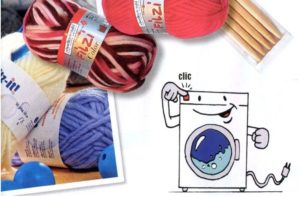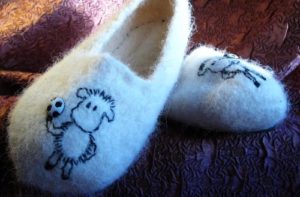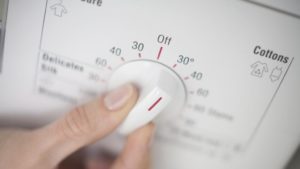Felting wool in a washing machine
 Automatic washing machines often come to the rescue in needlework, and wet felting in a washing machine is a prime example of this. By using automatic washing, you can save time and protect yourself from many failures. But an ideal result is possible if you take into account the characteristics of the wool used in the product and adhere to the basic rules of felting. How not to spoil the knitting and be satisfied with the result, we will tell you in detail below.
Automatic washing machines often come to the rescue in needlework, and wet felting in a washing machine is a prime example of this. By using automatic washing, you can save time and protect yourself from many failures. But an ideal result is possible if you take into account the characteristics of the wool used in the product and adhere to the basic rules of felting. How not to spoil the knitting and be satisfied with the result, we will tell you in detail below.
Rules for felting in a machine
Before you start wet felting from wool, you should thoroughly prepare and finally decide whether using a machine is justified. This method is not suitable for everyone, as the result depends on many factors.. These include the degree of dyeing of the wool, its color, knitting density and the program selected on the washing machine, temperature and spin cycle. In order not to lose your product, consider the following points.
- Only natural wool can shed. If its component in the yarn is below 60%, then the result will be practically zero.
- A loose knit holds better than a regular or thick knit.
- If you do the work by hand, then using a machine to consolidate the result will be justified.
- Yarn items may form pills, to avoid which you should place it in a special mesh bag or a regular pillowcase.

- The protective shell is also necessary for the safety of the machine, since particles of wool can get into the tank and cause it to jam or clog the drain system.
- An automatic machine with horizontal loading is more suitable, since it is more convenient to control the degree and progress of stalling. Front-facing models do not have this feature, but this is not so critical.
- To increase vibration and eliminate imbalance due to insufficient loading, it is recommended to add thick old items such as jeans.
- Cotton dust has a positive effect on drying, so it is recommended to add cotton linen to the drum.
- Spinning is allowed, but strong twisting is not. Otherwise, the item will easily become deformed.
- White and light wool mats worse.
Attention! The ideal solution would be to check the wool used and its suitability for machine felting by “running” a test sample in a machine.
Testing is more mandatory than desirable. The fact is that the final result of drying is influenced, in addition to the factors described above, by the hardness of the water, the type of detergent used, as well as vibration, the acceleration speed of the drum and the duration of the wash. All conditions cannot be calculated and predicted. Beginning handicrafts are recommended to start with simple items, scarves, mittens, hats, covers and vases. Particular attention should be paid to shrinkage - a properly felted product should not shrink by more than one third.
Description of the felting process
Having assessed the final result and created the most optimal conditions for drying, you can proceed directly to the process. It is important to follow the sequence of actions and not neglect these instructions. So, it is recommended to follow this algorithm:
- Carefully place one or more knitted items in a mesh bag or pillowcase.

- We load everything into the machine drum, filling the voids with thick colored linen, jeans or already washed towels (new ones easily lose their texture when washed with woolen items).
- Pour/fill the tray with a detergent or universal powder that matches the color.
- If colored materials are washed, a special anti-staining agent will not hurt. Conditioners and compounds used specifically for wool products are prohibited.
- Select a delicate cycle or another program that provides washing with large volumes of water. If you can adjust it yourself, set the temperature above 40 degrees, spin and rinse generously.
Attention! You cannot turn on a special mode for washing wool.
- A product that has not been completely rinsed must be rinsed in cold water yourself, and then lightly squeezed without twisting.
- We take the product out of the machine and give it a shape, for which we pull it tightly onto the desired shape (jar, fist, ball, vase, special stand for hats).
- Next, place it on a flat surface and dry it without hanging it on clothespins.
Felted items should shrink by about 30%. As a rule, one cycle is enough. If the result does not meet expectations, you can repeat the procedure up to 3 times. Each subsequent time, it is recommended to increase the washing temperature or select other modes. Often you have to experiment for several hours before proofreading your “formula”.
Opinions of experienced craftswomen
It is easy to see that ideal conditions are determined through trial and error. A kind of master class will be advice from experienced felting craftswomen who are ready to share their experiences. Below are opinions on the use of washing machines in the felting process:
Katerina Korshun
Sometimes I add bags and berets to the machine, but only after I’ve worked them well with my hands. I have long noticed that without thorough hand felting, the product often becomes deformed and crumpled. I do this: I put my creation in an old pillowcase, tie it tightly, load it with other things and set the wash to 40 minutes and 50 degrees. I pour soap shavings and rinse aid in the usual dose into the tray. But, to be honest, I don’t do this often, because after the machine the work is not so smooth, it gets very shaggy and it takes a long time to shape it with an iron and steam. But for the accelerated removal of several things at once, it is excellent.
Natalie Simkina
I believe that if you “tame” a machine, it will be a kind and irreplaceable friend. Personally, this is how it is for me. I wash bulky items, handbags and slippers in “free flight” at any temperature and duration. But I always hide my work in a special bag, nylon, mosquito net or tulle. But I top it up in the machine only after manual processing. For a light effect, I put it in the drum with the “Rinse/Spin” program, and then make adjustments with a needle. It is also possible to patch up after washing with a quick wash at 40 degrees for 30 minutes. And when choosing 60-90 degrees, the surface becomes absolutely flat and does not differ from real felt. This is how I prepare beads and balls.
Lada Moscow
I lay handbags and pillows in the car, and the result is not bad: everything is very smooth and without any visible rows. The main thing is to knit as little as possible, using thick knitting needles. But it is not suitable for all products. So, with slippers everything is more complicated, they turn out to be many times heavier and denser than hand-knitted ones and the heat retained inside, as for me, is completely different. Of course, this requires time and materials to experiment in order to achieve the ideal result. I believe that washing machines are for the lazy and very busy, as well as for tough items.
Katerina Kubeshova
I experiment with the machine regularly, and every time I swear that I will not get involved in this again. The last attempt was successful, although with some modifications. It was like this: first I processed the handbag on a sanding machine, wrapped it in a pillowcase and started the cycle. Then I got scared - the washed item had become matted just a little bit, holes were visible and the size remained completely unchanged. I gave up on this idea and only remembered it two weeks later. I lathered it, wet it, rubbed it with my hands and got an excellent bag, thin and durable.
I think I'll try again. For now I only use the machine for regularly rinsing and spinning dry clothes - it’s very convenient.
Ekaterina Logacheva
My machine has never let me down. I always leave all the scarves in the machine. I do this: I spin a knitted product a hundred times in IKEA film and immediately throw it into the drum. At the end I get perfect quality without defects and pah-pah-pah, after straightening and steaming - you can’t tell it from factory production. Just recently, I knitted a hat for the first time, spun it 200 times and washed it. It turned out very well! The mittens haven’t spoiled either!”
If you take into account the recommendations given and the personal experience of professional needlewomen, then felting in a washing machine will go quickly and with a predictable result. The main thing is to adapt to the capabilities of your washing machine and be sure to test the selected mode with a test sample.
Interesting:
Reader comments
- Share your opinion - leave a comment
Categories
Washing machine repair


For buyers

For users

Dishwasher

















Add a comment